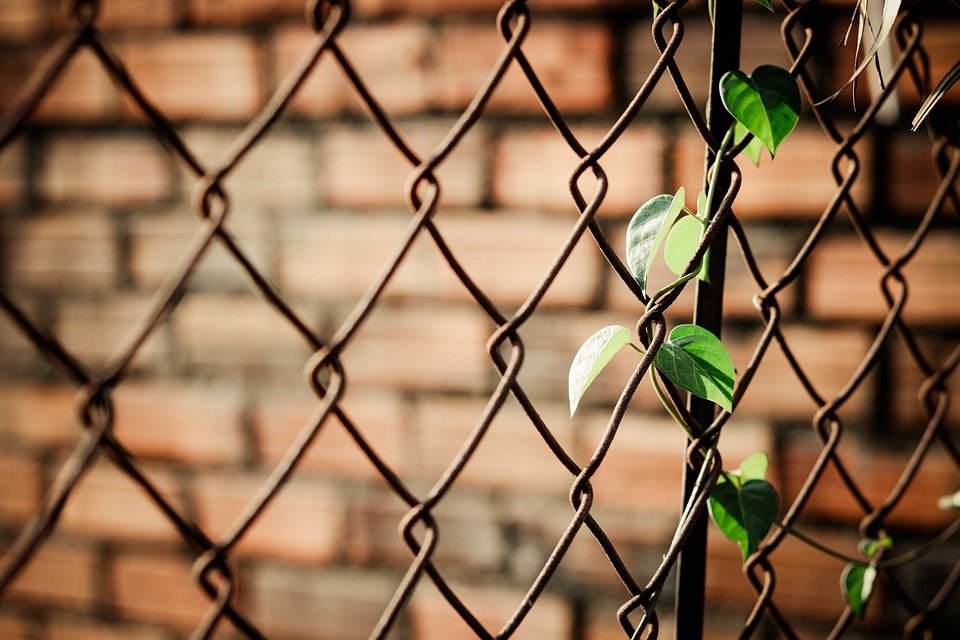While ivy like shown above may seem like a beautiful addition to your chain link fence, plant growth can be destructive to your fence! We’ll talk about that and 7 other routine maintenance tips for chain link fences. Thankfully, chain link fence is relatively maintenance free, but taking a few hours out of your summer to look over your fence, make repairs as necessary, and perform proactive measures can avoid costly problems down the road.
1.) Remove Plant Growth & Vines
It’s amazing how quickly vines and other vegetation can grow, overtaking and intertwining into a chain link fence. Some home owners might even enjoy the look of greenery on their fence, but despite the protective coatings applied to chain link fencing from the factory, it’s important to take steps to reduce the amount of moisture that collects as a result of these plants.
Branches and ivy can also attach themselves and grow into the fence in ways that stretch and stress the fabric. Trees can permanently destroy the structural integrity of the fence by bending rails and it’s not uncommon to see trees that have never been cut back absorb a chain link fence into the trunk.
Additionally, raking back leaves and other debris that can collect at the base of the fence will help avoid collection of moisture.
2.) Apply Annual Rust Protection Products
Fence products available through Central Iowa Fencing come with leading rust protection and competitive warranties, but years of morning dew, snow, and heavy rains can very slowly weather away a these coatings. A chain link fence can be expected to last 25 to 30 years, but that is a lot of years of moisture collection and withstanding the elements.
Taking maintenance precautions to continue to apply rust protection products can enhance the life of your fence. Protective coatings applied on an annual basis will not only help ensure your fence looks beautiful over it’s life span, but prevent or reduce the effects of rusting during that life span.
Rust protection products should be sprayed over the surfaces of the fence, but it is particularly important to focus on the lower section of fence where snow and leaf pile accumulation have the most tendency to cause moisture issues.
3.) Clean Your Fence Regularly
Your fence sits open to the natural elements 24 hours a day, collecting dirt and animal droppings. A dirty chain link fence is not only unsightly, but depending upon what spills onto your fence could break down protective coatings through chemical reactions.
Cleaning off dirt and grime from a fence is easy and generally only requires a power washer to blast away what has collected on the fence. Occasionally, especially for stuck on particles, you might consider using dish soap and a scrub brush to break those items free.
4.) Avoid Climbing Your Chain Link Fence
Chain link fencing does a great job at securing a perimeter, but the occasional ball kicked a little too hard could make jumping the fence to grab it seem like an appealing convenience. It’s important to avoid climbing the fence fabric to avoid injury, but climbing a fence can also cause damage to the chain link fence components.
Fence fabric is not designed to be climbed and the structural components of the fence could bend with the additional weight of a human. If you find yourself constantly jumping the fence in lieu of using the gate, you might consider contacting us to add an additional gate a more convenient location.
5.) Oil Hinges
Speaking of gates, your chain link fence likely has one. The hardware used for your gate is designed to withstand wear and tear, but like the rest of the components of your fence, annual review of your gates moving components will ensure they function correctly and reduce wear.
Reducing friction and improving the smoothness of your gate by oiling moving parts will make sure that your gate operates correctly. A correctly operating gate will ultimately reduce the amount of stress your gate encounters from being opened and closed.
6.) Tighten Fence Hardware
Throughout your fence, there are various components that require bolted or screwed connections. Over time, it’s possible hardware could slowly loosen and cause parts to disconnect.
Loose hardware is not only an issue for the structural integrity of your fence, but could cause injury!
7.) Fix Posts & Rail That Are Bent
Despite your best efforts, it’s possible damage could occur to your fence. You may tell your kids to not climb the fence (per tip #4) and still end up with rail or bent post. When damage does occur to your fence, it’s important to replace those components with straight, structurally sound replacements.
Leaning or heaving posts can cause stress throughout the fence.
8.) Fix Issues As They Occur
Probably the most important tip is to make sure to make chain link fence repairs as needed and not wait for problems to collect before they are addressed. Taking immediate action for damage and maintenance is the best solution for increasing the life span of your fence as smaller issues can quickly become bigger issues. Those bigger issues are going to be more expensive to repair than taking immediate action as well.
Unresolved small repairs typically turn into more complicated repairs where a fencing professional is required to diagnose!
Regardless of the complication of your chain link fence repairs, you can rely on the trusted folks at Central Iowa Fencing. Our teams in central and eastern Iowa are ready to assist your with all your chain link fence maintenance and repair work. Simply contact us and we’ll be happy to provide a free estimate!

